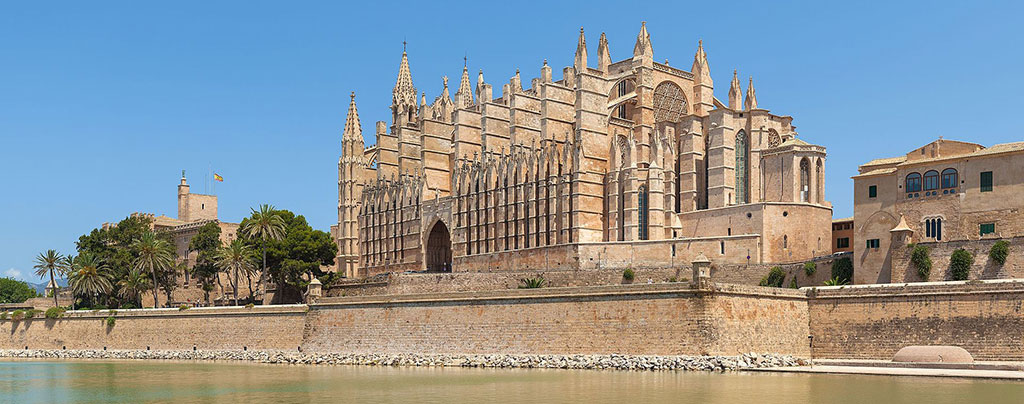The Cathedral of Palma de Mallorca, popularly known as La Seu, is Spain’s second largest cathedral, surpassed only by Seville Cathedral.

Awarded Historical-Artistic Monument status by the Spanish government, which means that it is protected under the rules of the Ministry of Culture, the cathedral is a massive construction. It is 121 meters long and 55 meters wide, covering an area of 6,655m2. The nave is the second highest in Europe with 44 meters to the ceiling. Only the cathedral of Beauvais has a higher nave at 48 meters.
La Seu is one of the world’s most admired Gothic temples, and a must on the itinerary of any visitor to Mallorca. Set near the Bay of Palma, it towers over the city and it is the first thing you can make out when you approach Palma de Mallorca from the sea side.
With its location on the edge of the Mediterranean it is the only cathedral in the world that mirrors its image in the sea. This effect was ruined in the urban development that took place over the years, and La Seu became separated from the sea, but it was brought back in the 1970s with the construction of a salt water lake as part of a nearby park.
Construction of the cathedral was started at the end of the 13th century, and the temple was finished in the middle of the 17th century. The project was started by the king of Aragon, Jaime I, to fulfil a promise he had made to the Virgin Mary when he was saved from a ship wreck on open sea.
La Seu did not stop developing after completion, and it has been renovated many times over the years by some of Spain’s most illustrious architects and artists. One of the most outstanding contributions to the cathedral was Antoni Gaudi’s 10 year stretch from 1904 onwards, when Bishop Campins contracted him to carry out substantial reforms.
Gaudi ordered the dismantling of two altarpieces that blocked the congregation’s view of the Bishop’s throne. He located a high altar in front of the throne and positioned a baldachin of stunning design above it.
He moved the choir stand, opened up formerly bricked over windows and added nine stained glass windows, as well as contributing with furniture, lighting, ornamental wrought metal work, ceramic and paintings. However, he left the project unfinished when the bishop died and he fell out with the contractor. But the works he did carry out are amazing and they alone merit a visit to the cathedral.
The contemporary Spanish artist Miquel Barceló was contracted to carry out a mural in the Capilla del SantIsimo chapel, which he did with stunning results in the years 2001-2006. The mural covers 300m2 and Barceló chose the miracle of the five loaves and two fish as his subject. The mural is one of the main attractions of La Seu.
One of the cathedral’s rose windows is the world’s largest in a Gothic cathedral, and one of the largest throughout the Christian world. It has a diameter of 13.8 meters and consists of 1,236 pieces of coloured glass which combine into a beautiful and colourful pattern. It doubles as a sundial which marks hours and seasons. The rose window has been damaged on several occasions and has had to be restored; last time was during the Civil War when a bomb exploded in the Almudaina Palace close by.
Twice a year, on 2nd February and 11th November, a unique event occurs in the cathedral: a spectacular luminous phenomenon known as ‘the vision of the eight’. On those dates, the sun rays beaming through the largest rose window project an image of the rosette onto the wall opposite just below the smaller rose window so that they form the figure of eight, the upper part made from glass, the lower from light. The numerical symbol of eight is the union of the earthly and the spiritual.
In a document from the year 1306, while the cathedral was under construction, King Jaime II, son of King Jaime I who had ordered the construction of the cathedral, bade the construction of a chapel in which he would be entombed.
From then on, the Chapel of the Trinity, at the end of the cathedral in the presbytery, became a royal mausoleum where the sovereign kings of Mallorca, Jaime II and Jaime III were buried. In around 1950 the Catalan artist Federico Mares sculpted the tombs, and the chapel could be considered a second temple inside the cathedral.
It is often said that La Seu transmits a magic sensation. The numerous windows (59 large windows and five rose windows) combined with the fact that the cathedral is right next to the sea, create a beautiful visual experience; when the sun is at its highest and beams its light in though the windows, some of it reflected off the watel and every corner of the huge space is illuminated in beautiful colours, La Seu really does live up to one of its other nicknames: The Cathedral of the Light.